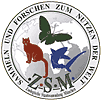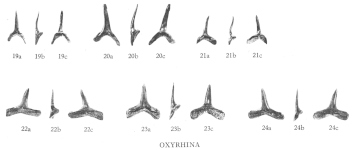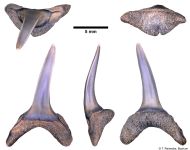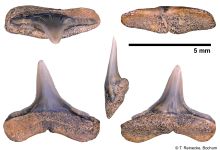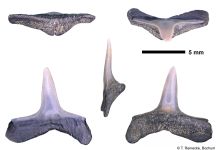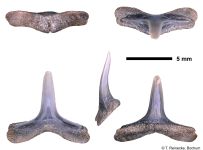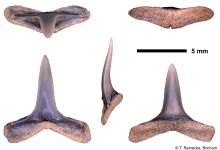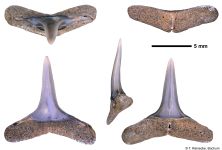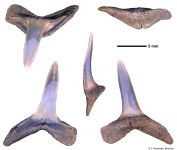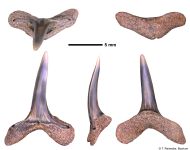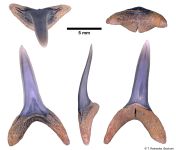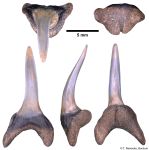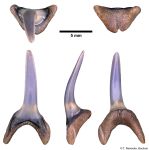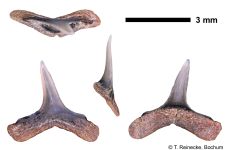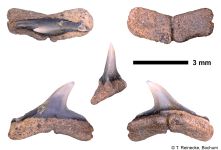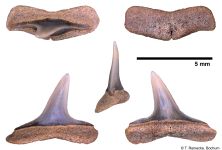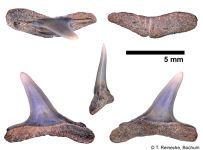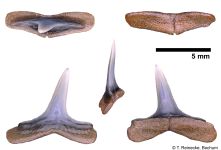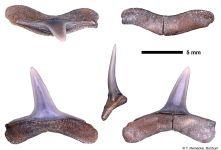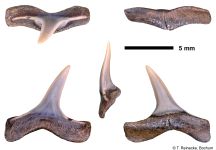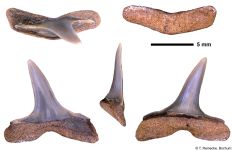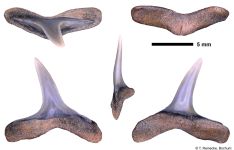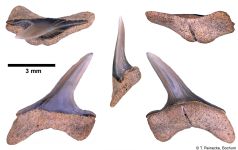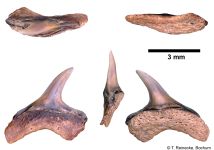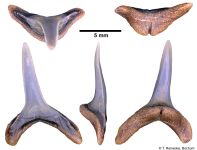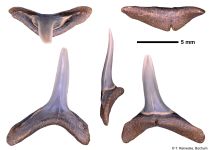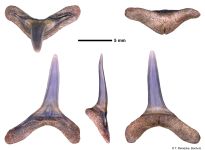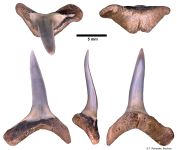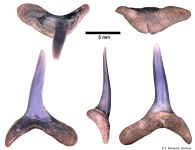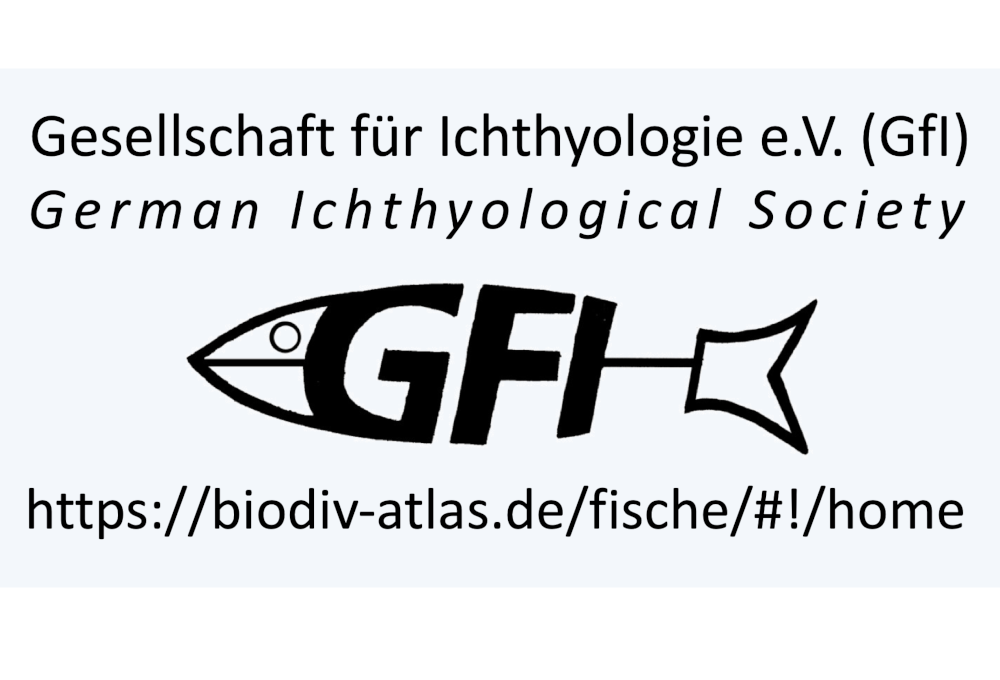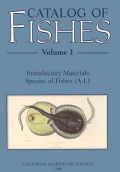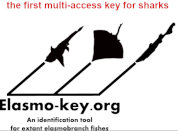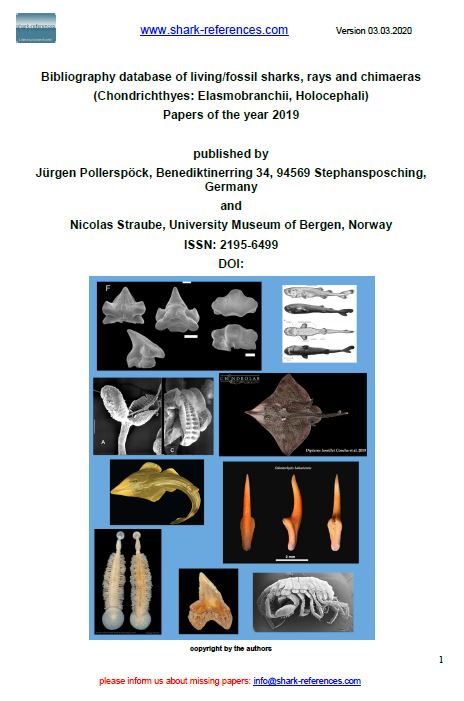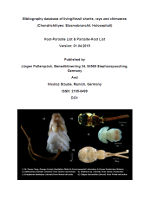Anomotodon sheppeyensis
(Casier, 1966)
Classification: Elasmobranchii Lamniformes Mitsukurinidae
Reference of the original description
Faune ichthyologique du London Clay. Trustees of the British Museum: 496 pp., 82 fig., 68 pl.
Faune ichthyologique du London Clay. Trustees of the British Museum: 496 pp., 82 fig., 68 pl.
Image of the original description
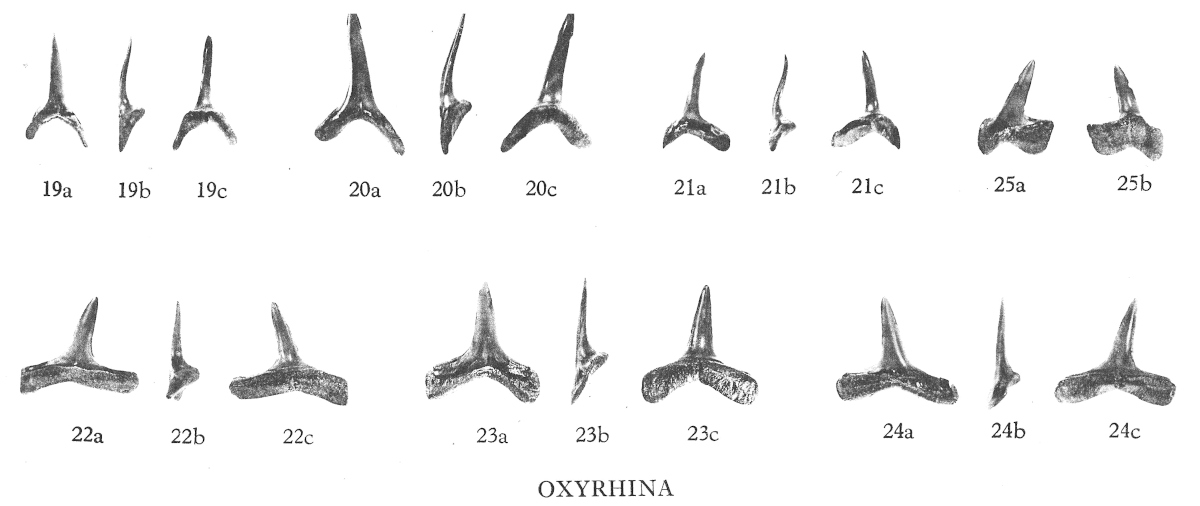
Oxyrhina sheppeyensis Casier, 1966; Holotype, NHMUK P 30804, pl. 5, fig 20; Paratypes, NHMUK P 21732, 21731, 21903, 26615, 26616, pl. 5, figs 19, 21-24; no type: NHMUK P 21640, pl. 5, fig. 25; London Clay Formation, Ypresian; Sheppey, Kent, UK.

Oxyrhina sheppeyensis Casier, 1966; Holotype, NHMUK P 30804, pl. 5, fig 20; Paratypes, NHMUK P 21732, 21731, 21903, 26615, 26616, pl. 5, figs 19, 21-24; no type: NHMUK P 21640, pl. 5, fig. 25; London Clay Formation, Ypresian; Sheppey, Kent, UK.
Synonyms / new combinations and misspellings
Anomotodon aff. sheppeyensis, Anomotodon cf. sheppeyensis, Isurus sheppeyensis, Oxyrhina sheppeyensis
Anomotodon aff. sheppeyensis, Anomotodon cf. sheppeyensis, Isurus sheppeyensis, Oxyrhina sheppeyensis
Types
Anomotodon sheppeyensis
Oxyrhina sheppeyensis
Holotype: NHMUK: P.30804; Paratype: NHMUK: P.21732; NHMUK: P.21731; NHMUK: P.21903; NHMUK: P.26615; NHMUK: P.26616;
Anomotodon sheppeyensis
Oxyrhina sheppeyensis
Holotype: NHMUK: P.30804; Paratype: NHMUK: P.21732; NHMUK: P.21731; NHMUK: P.21903; NHMUK: P.26615; NHMUK: P.26616;
Description:
Citation: Anomotodon sheppeyensis (Casier, 1966): In: Database of fossil elasmobranch teeth www.shark-references.com, World Wide Web electronic publication, Version 12/2025
Please send your images of "Anomotodon sheppeyensis" to info@shark-references.com
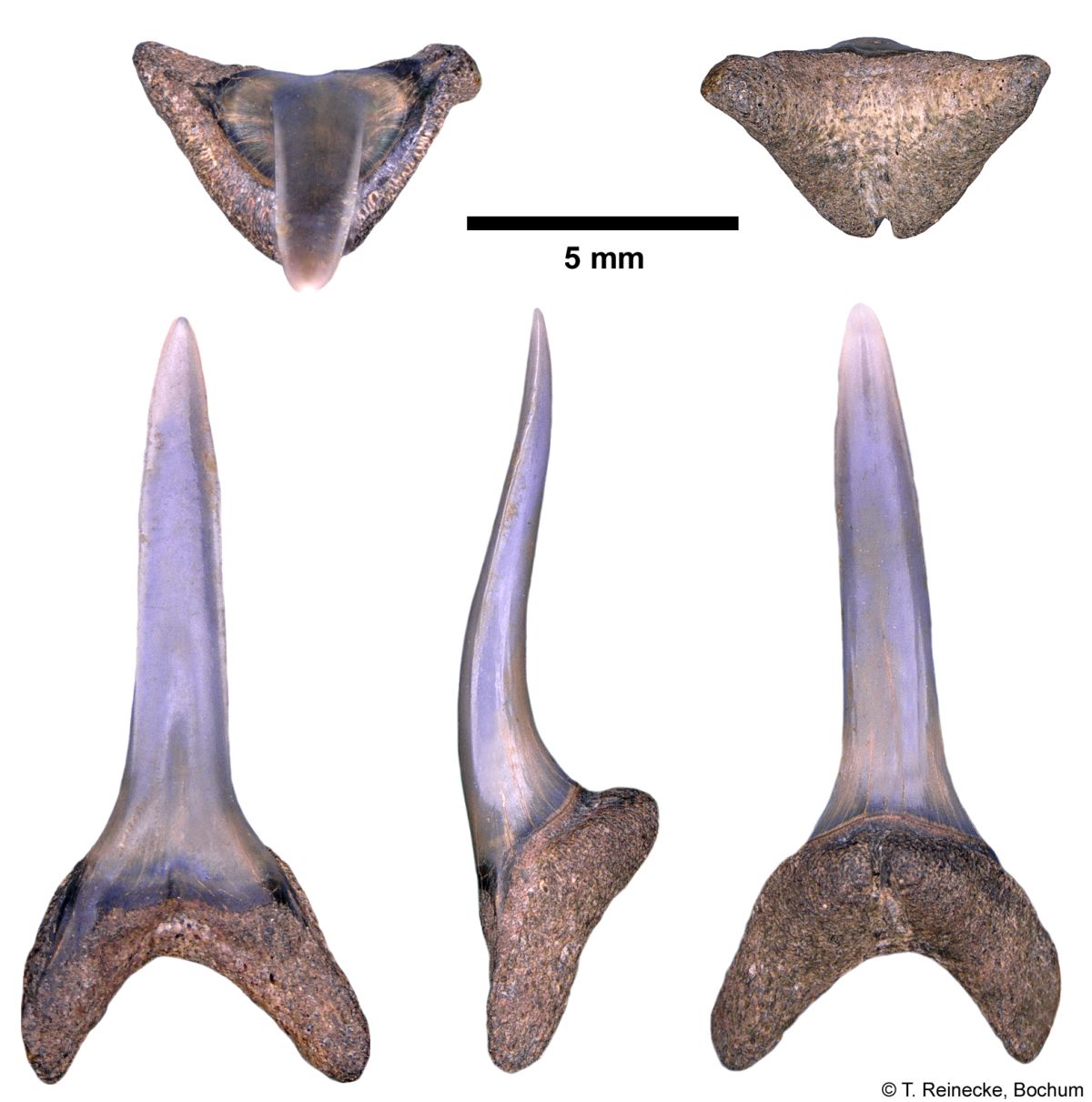
Anomotodon sheppeyensis (Casier, 1966); London Clay Formation, Division D, Sheppey Member, Ypresian, early Eocene; Cliff Reach, Burnham-on-Crouch, Essex, UK; © T. Reinecke, Bochum

Anomotodon sheppeyensis (Casier, 1966); London Clay Formation, Division D, Sheppey Member, Ypresian, early Eocene; Cliff Reach, Burnham-on-Crouch, Essex, UK; © T. Reinecke, Bochum
Description
Original diagnosis after Casier (1966) p. 83 [425]: Parmi les nombreuses dents du London Clay attribuées (in coll.) à Oxyrhina nova Winkler, il en est qui ne sont pas sans avoir quelques affinités réelles avec cette espèce mais elles appartiennent en réalité, comme nous le verrons bientôt, à une autre espèce.
La couronne des dents antérieures est très élancée et présente une nette courbure sigmoïdale, plus accentuée dans les dents qui ont dû appartenir à la dentition de la mâchoire inférieure et principalement dans la forme juvénile. Elle porte parfois quelques plis obsolètes à la base de sa face interne. La taille de ces dents peut atteindre 23 mm de hauteur, racine comprise. Les talons sont très peu importants et étroits, la protubérance interne de la racine parfaitement divisée par un sillon renfermant le foramen nutritif. Les deux branches radiculaires sont fines.
Les dents latérales, surtout celles de la mâchoire inférieure, ont une racine très comprimée, élargie, et les talons de la couronne s'y prolongent également loin de la couronne proprement dite. Dans les exemplaires de petite taille, le bord basilaire externe est parfois plissé, comme nous l'avons vu dans le cas des antérieures. Dans un des exemplaires, les plis sont groupés en deux séries, chacune intéressant un des talons de la couronne. Les branches radiculaires s'écartent peu ou pas du tout du plan de la face externe de la couronne.
Original diagnosis after Casier (1966) p. 83 [425]: Parmi les nombreuses dents du London Clay attribuées (in coll.) à Oxyrhina nova Winkler, il en est qui ne sont pas sans avoir quelques affinités réelles avec cette espèce mais elles appartiennent en réalité, comme nous le verrons bientôt, à une autre espèce.
La couronne des dents antérieures est très élancée et présente une nette courbure sigmoïdale, plus accentuée dans les dents qui ont dû appartenir à la dentition de la mâchoire inférieure et principalement dans la forme juvénile. Elle porte parfois quelques plis obsolètes à la base de sa face interne. La taille de ces dents peut atteindre 23 mm de hauteur, racine comprise. Les talons sont très peu importants et étroits, la protubérance interne de la racine parfaitement divisée par un sillon renfermant le foramen nutritif. Les deux branches radiculaires sont fines.
Les dents latérales, surtout celles de la mâchoire inférieure, ont une racine très comprimée, élargie, et les talons de la couronne s'y prolongent également loin de la couronne proprement dite. Dans les exemplaires de petite taille, le bord basilaire externe est parfois plissé, comme nous l'avons vu dans le cas des antérieures. Dans un des exemplaires, les plis sont groupés en deux séries, chacune intéressant un des talons de la couronne. Les branches radiculaires s'écartent peu ou pas du tout du plan de la face externe de la couronne.
Remarks
shark-references Species-ID=263;
shark-references Species-ID=263;
References

Elasmobranchs from the Lower Eocene Kalinino Formation of the Alai River, Saratov Region of Russia. Historical Biology, 36(4), 783–795
DOI: 10.1080/08912963.2023.2184691

Faszination Haie – Die Welt der fossilen und der lebenden Haie. Der Steinkern, 58, 1–116

Fossile hajtaender fra Trelde Naes. Self-published

Climate cooling and clade competition likely drove the decline of lamniform sharks. Proceedings of the National Academy of Sciences of the United States of America, 116(41), 20584–20590
DOI: 10.1073/pnas.1902693116
A study of the sharks and rays from the Lillebælt Clay (Early–Middle Eocene) of Denmark, and their palaeoecology. Bulletin of the Geological Society of Denmark, 62, 39–88
DOI: 10.37570/bgsd-2014-62-04

Surface-water freshening and high-latitude river discharge in the Eocene North Sea. Journal of the Geological Society, 166, 969–980
DOI: 10.1144/0016-76492008-068

London Clay Fossils of Kent and Essex. Rochester, Kent, Medway Fossil and Mineral Society, 228 p, ISBN: 978–0–9538243–1–1

(Elasmobranchs of the western margin of the West Siberian Paleogene basin.) «in russian». Ekaterinburg: IGG UB RAS, 2006, 224 p., ICC 5–94332–048–2

Nouvelles faunes de sélaciens (Elasmobranchii, Neoselachii) de l'Éocène des Landes (Sud-Ouest, France). Implication dans les connaissances des communautés d'eaux profondes. Palaeo Ichthyologica, 10, 1–128

Report of Field Meeting to Burnham-on-Crouch, Essex. Tertiary Research, 22(1-4), 89–92

London Clay Fossils of the Isle of Sheppey. Medway Lapidary and Mineral Society, ISBN 0-9538243-0-6, 100pp.

Les élasmobranches fossiles du Paléogène des Landes (Sud-Ouest, France). Implications dans la connaissance des communautés d'élasmobranches d'eaux profondes. Evolution des Squaliformes et paléoécologie. 211 p., 23 fig., annexes, 40 pl. Dipl. Doct., Univ. Montpellier II.

Fossil sharks, rays and chimaeroids of the English Tertiary period. Gosport Museum, 1–47, 10 fig., 3 tabl., 16 pl.

The distribution of sharks, rays and chimaeroids in the English Palaeogene. Tertiary Research, 3(1), 13–19

Sélaciens nouveaux du London Clay de l'Essex (Yprésien du Bassin de Londres). Geobios, 9(5), 551–575
DOI: 10.1016/S0016-6995(76)80024-1

Faune ichthyologique du London Clay. Trustees of the British Museum: 496 pp., 82 fig., 68 pl.

Elasmobranchs from the Lower Eocene Kalinino Formation of the Alai River, Saratov Region of Russia. Historical Biology, 36(4), 783–795
DOI: 10.1080/08912963.2023.2184691

Faszination Haie – Die Welt der fossilen und der lebenden Haie. Der Steinkern, 58, 1–116

Fossile hajtaender fra Trelde Naes. Self-published

Climate cooling and clade competition likely drove the decline of lamniform sharks. Proceedings of the National Academy of Sciences of the United States of America, 116(41), 20584–20590
DOI: 10.1073/pnas.1902693116
A study of the sharks and rays from the Lillebælt Clay (Early–Middle Eocene) of Denmark, and their palaeoecology. Bulletin of the Geological Society of Denmark, 62, 39–88
DOI: 10.37570/bgsd-2014-62-04

Surface-water freshening and high-latitude river discharge in the Eocene North Sea. Journal of the Geological Society, 166, 969–980
DOI: 10.1144/0016-76492008-068

London Clay Fossils of Kent and Essex. Rochester, Kent, Medway Fossil and Mineral Society, 228 p, ISBN: 978–0–9538243–1–1

(Elasmobranchs of the western margin of the West Siberian Paleogene basin.) «in russian». Ekaterinburg: IGG UB RAS, 2006, 224 p., ICC 5–94332–048–2

Nouvelles faunes de sélaciens (Elasmobranchii, Neoselachii) de l'Éocène des Landes (Sud-Ouest, France). Implication dans les connaissances des communautés d'eaux profondes. Palaeo Ichthyologica, 10, 1–128

Report of Field Meeting to Burnham-on-Crouch, Essex. Tertiary Research, 22(1-4), 89–92

London Clay Fossils of the Isle of Sheppey. Medway Lapidary and Mineral Society, ISBN 0-9538243-0-6, 100pp.

Les élasmobranches fossiles du Paléogène des Landes (Sud-Ouest, France). Implications dans la connaissance des communautés d'élasmobranches d'eaux profondes. Evolution des Squaliformes et paléoécologie. 211 p., 23 fig., annexes, 40 pl. Dipl. Doct., Univ. Montpellier II.

Fossil sharks, rays and chimaeroids of the English Tertiary period. Gosport Museum, 1–47, 10 fig., 3 tabl., 16 pl.

The distribution of sharks, rays and chimaeroids in the English Palaeogene. Tertiary Research, 3(1), 13–19

Sélaciens nouveaux du London Clay de l'Essex (Yprésien du Bassin de Londres). Geobios, 9(5), 551–575
DOI: 10.1016/S0016-6995(76)80024-1

Faune ichthyologique du London Clay. Trustees of the British Museum: 496 pp., 82 fig., 68 pl.
